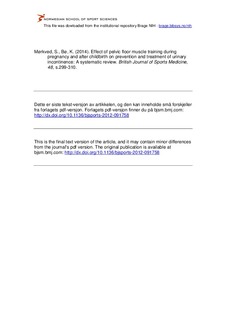| dc.contributor.author | Mørkved, Siv | |
| dc.contributor.author | Bø, Kari | |
| dc.date.accessioned | 2014-05-23T07:08:58Z | |
| dc.date.available | 2014-05-23T07:08:58Z | |
| dc.date.issued | 2013-01-30 | |
| dc.identifier.citation | British Journal of Sports Medicine. 2014, 48, 299-310 | nb_NO |
| dc.identifier.uri | http://hdl.handle.net/11250/195336 | |
| dc.description | I Brage finner du siste tekst-versjon av artikkelen, og den kan inneholde ubetydelige forskjeller fra forlagets pdf-versjon. Forlagets pdf-versjon finner du på bjsm.bmj.com: http://dx.doi.org/10.1136/bjsports-2012-091758 / In Brage you'll find the final text version of the article, and it may contain insignificant differences from the journal's pdf version. The definitive version is available at bjsm.bmj.com: http://dx.doi.org/10.1136/bjsports-2012-091758 | nb_NO |
| dc.description.abstract | Background Urinary incontinence (UI) is a common condition in women causing reduced quality of life and withdrawal from fitness and exercise activities. Pregnancy and childbirth are established risk factors. Current guidelines for exercise during pregnancy have no or limited focus on the evidence for the effect of pelvic floor muscle training (PFMT) in the prevention and treatment of UI.
Aims Systematic review to address the effect of PFMT during pregnancy and after delivery in the prevention and treatment of UI.
Data sources PubMed, CENTRAL, Cochrane Library, EMBASE and PEDro databases and hand search of available reference lists and conference abstracts (June 2012).
Methods Study eligibility criteria: Randomised controlled trials (RCTs) and quasiexperimental trials published in the English language. Participants: Primiparous or multiparous pregnant or postpartum women. Interventions: PFMT with or without biofeedback, vaginal cones or electrical stimulation. Study appraisal and synthesis methods: Both authors independently reviewed, grouped and qualitatively synthesised the trials.
Results 22 randomised or quasiexperimental trials were found. There is a very large heterogeneity in the populations studied, inclusion and exclusion criteria, outcome measures and content of PFMT interventions. Based on the studies with relevant sample size, high adherence to a strength-training protocol and close follow-up, we found that PFMT during pregnancy and after delivery can prevent and treat UI. A supervised training protocol following strength-training principles, emphasising close to maximum contractions and lasting at least 8 weeks is recommended.
Conclusions PFMT is effective when supervised training is conducted. Further high-quality RCTs are needed especially after delivery. Given the prevalence of female UI and its impact on exercise participation, PFMT should be incorporated as a routine part of women's exercise programmes in general. | nb_NO |
| dc.language.iso | eng | nb_NO |
| dc.publisher | BMJ Publishing Group | nb_NO |
| dc.subject | VDP::Samfunnsvitenskap: 200::Samfunnsvitenskapelige idrettsfag: 330::Andre idrettsfag: 339 | nb_NO |
| dc.subject | exercise therapy / methods | |
| dc.subject | female | |
| dc.subject | pelvic floor / physiology | |
| dc.subject | postnatal care / methods | |
| dc.subject | pregnancy | |
| dc.subject | pregnancy complications / prevention & control | |
| dc.subject | prenatal care / methods | |
| dc.subject | time factors | |
| dc.subject | urinary incontinence / prevention & control | |
| dc.title | Effect of pelvic floor muscle training during pregnancy and after childbirth on prevention and treatment of urinary incontinence: A systematic review | nb_NO |
| dc.type | Journal article | nb_NO |
| dc.type | Peer reviewed | nb_NO |
| dc.source.journal | British Journal of Sports Medicine | nb_NO |
| dc.identifier.doi | 10.1136/bjsports-2012-091758 | |
| dc.description.localcode | Seksjon for idrettsmedisinske fag / Department of Sports Medicine | nb_NO |
